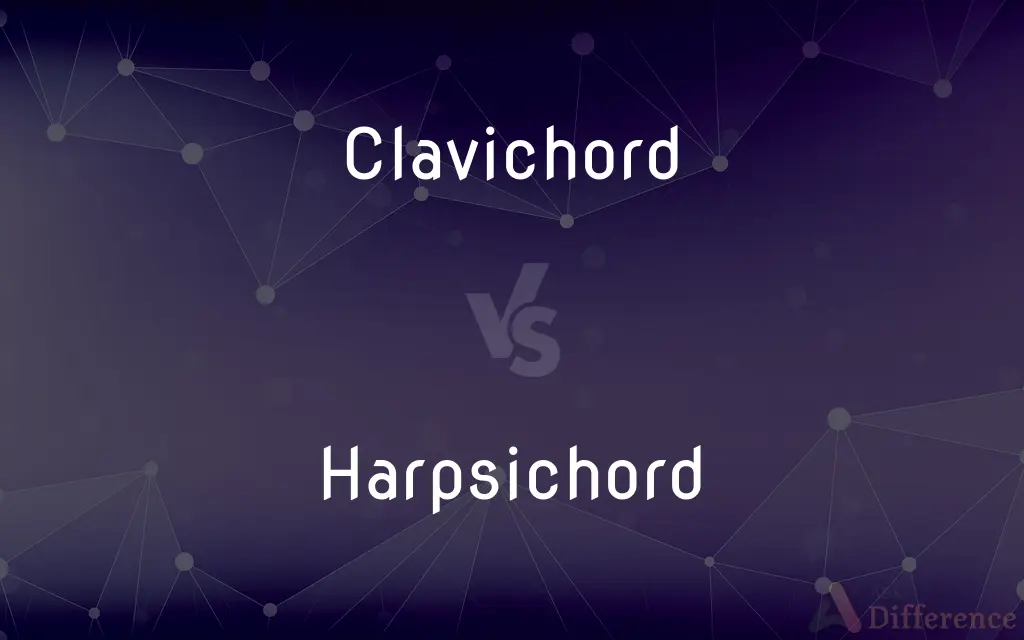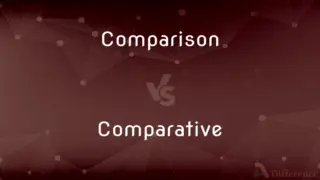Clavichord vs. Harpsichord — What's the Difference?
Edited by Tayyaba Rehman — By Fiza Rafique — Updated on April 1, 2024
A clavichord produces sound by striking strings with small metal blades, offering expressive control, while a harpsichord plucks strings with quills, creating a brighter tone.

Difference Between Clavichord and Harpsichord
Table of Contents
ADVERTISEMENT
Key Differences
The clavichord and harpsichord are both keyboard instruments popular in the Renaissance and Baroque periods, but they differ significantly in mechanics, sound production, and musical expression. The clavichord produces sound by striking strings with small metal tangents, allowing dynamic control through touch sensitivity. On the other hand, the harpsichord generates sound by plucking strings with plectra, usually made of quill or plastic. This action results in a bright and distinctive sound that lacks the dynamic range of the clavichord.
The clavichord's action allows for vibrato effects (bebung), giving it a unique expressive advantage. This is achieved by varying the pressure on the keys after the initial note attack, which slightly changes the pitch and volume. Such expressive control is absent in the harpsichord, where the tone and volume remain consistent regardless of key pressure.
Regarding repertoire, the clavichord is closely associated with the music of composers like J.S. Bach, who appreciated its expressive capabilities, especially for solo keyboard music. In contrast, the harpsichord was the preferred instrument for much of the Baroque period's keyboard compositions, including the works of Handel and Scarlatti, due to its brilliance and ability to carry across larger rooms or with other instruments.
Both instruments have experienced revivals in recent times, with musicians and composers exploring their unique sounds and expressive capacities. The clavichord appeals to those interested in historical performance practices and nuanced, intimate recitals, whereas the harpsichord continues to be a staple in Baroque ensembles and those seeking its distinctive timbral qualities.
Comparison Chart
Sound Production
Strings are struck by metal tangents.
Strings are plucked by quills or plectra.
ADVERTISEMENT
Dynamic Range
Wide, allows for expressive nuances.
Limited, with consistent volume.
Expressive Control
High, capable of vibrato and dynamic changes.
None, as volume and tone are constant.
Preferred Setting
Intimate, due to softer sound.
Concert and ensemble, due to louder volume.
Repertoire
Suited for solo keyboard works and intimate performances.
Favored for ensemble pieces and Baroque compositions.
Compare with Definitions
Clavichord
A small, quiet keyboard instrument using strings struck by metal tangents.
The musician practiced Bach’s preludes on a clavichord for their authentic sound.
Harpsichord
Characterized by its inability to vary dynamics through touch.
Despite the harpsichord's dynamic limitations, the performer conveyed emotion through tempo.
Clavichord
Known for its expressive capabilities, including vibrato.
She mastered the art of bebung on the clavichord.
Harpsichord
A keyboard instrument that produces sound by plucking strings.
The harpsichord’s bright tone filled the concert hall.
Clavichord
Ideal for intimate performances and personal practice.
He preferred the clavichord for its soft, introspective tone.
Harpsichord
Often decorated elaborately, reflecting its status.
The ornate harpsichord was a centerpiece of the Baroque ensemble.
Clavichord
Has a historical significance in European music.
The museum displayed a clavichord from the 17th century.
Harpsichord
Historical importance in the Baroque period.
The composer wrote extensively for the harpsichord, a hallmark of the era.
Clavichord
Allows dynamic control through touch.
The delicate nuances of the clavichord piece demanded precise touch.
Harpsichord
Preferred for its clear, penetrating sound in ensemble settings.
Her harpsichord playing added brilliance to the baroque orchestra.
Clavichord
The clavichord is a Western European stringed rectangular keyboard instrument that was used largely in the Late Middle Ages, through the Renaissance, Baroque and Classical eras. Historically, it was mostly used as a practice instrument and as an aid to composition, not being loud enough for larger performances.
Harpsichord
A harpsichord (Italian: clavicembalo, French: clavecin, German: Cembalo, Spanish: clavecín, Portuguese: cravo, Dutch: klavecimbel) is a musical instrument played by means of a keyboard. This activates a row of levers that turn a trigger mechanism that plucks one or more strings with a small plectrum made from quill or plastic.
Clavichord
An early keyboard instrument with a soft sound produced by small brass wedges striking horizontal strings.
Harpsichord
A keyboard instrument with horizontal strings which run perpendicular to the keyboard in a long tapering case, and are plucked by points of quill, leather, or plastic operated by depressing the keys. It is used chiefly in European classical music of the 16th to 18th centuries.
Clavichord
(musical instruments) An early keyboard instrument producing a soft sound by means of metal blades (called tangents) attached to the inner ends of the keys gently striking the strings.
Harpsichord
A keyboard instrument whose strings are plucked by means of quills or plectrums.
Clavichord
A keyed stringed instrument, now superseded by the pianoforte. See Clarichord.
Harpsichord
(musical instruments) A musical instrument with a keyboard that produces sound through a mechanical process. When the performer presses a key, a corresponding plectrum plucks a tuned string. Harpsichords originated in late medieval Europe and is one of the most important instruments used to perform Baroque music.
Clavichord
An early stringed instrument like a piano but with more delicate sound
Harpsichord
A harp-shaped instrument of music set horizontally on legs, like the grand piano, with strings of wire, played by the fingers, by means of keys provided with quills, instead of hammers, for striking the strings. It is now superseded by the piano.
Harpsichord
A clavier with strings that are plucked by plectra mounted on pivots
Common Curiosities
What is the main difference between a clavichord and a harpsichord?
The clavichord produces sound by striking strings, allowing dynamic control, while the harpsichord plucks strings, creating a consistent volume.
Can the clavichord produce vibrato?
Yes, the clavichord can produce a vibrato effect known as bebung, adding to its expressive capabilities.
What kind of music is best suited for the clavichord?
Solo keyboard works that benefit from subtle dynamic and expressive nuances are well-suited for the clavichord.
Why can’t the harpsichord produce dynamics like the clavichord?
The harpsichord's mechanism plucks strings, which produces a consistent sound level regardless of how hard the keys are pressed.
Which instrument was more popular during the Baroque period?
The harpsichord was more popular in ensemble and solo performances due to its louder volume.
Can you play dynamic variations on a harpsichord?
No, the harpsichord cannot produce dynamic variations through key pressure.
Is the clavichord louder than the harpsichord?
No, the clavichord is generally quieter than the harpsichord, making it more suited for intimate settings.
Are clavichords still made and played today?
Yes, clavichords are still manufactured and appreciated by enthusiasts of historical keyboard instruments.
Are clavichord and harpsichord easy to maintain?
Both require specialized maintenance, but the clavichord is generally simpler due to its less complex mechanism.
Was the clavichord used in large concert settings?
Rarely, due to its softer volume, the clavichord was more suited to private practice and intimate performances.
How do performers express emotion on a harpsichord?
Through variations in timing, articulation, and the strategic use of the instrument's registration and ornamental devices.
What is bebung on the clavichord?
Bebung is a vibrato effect on the clavichord, achieved by varying key pressure after striking a note.
What makes the harpsichord sound brighter than the clavichord?
The plucking action of the harpsichord's plectra creates a brighter, more resonant sound compared to the muted tones of the clavichord.
Can both instruments be used for all types of Baroque music?
While both can play Baroque music, the harpsichord is generally preferred for its volume and clarity in ensemble pieces.
Share Your Discovery

Previous Comparison
Civilization vs. Society
Next Comparison
Comparison vs. ComparativeAuthor Spotlight
Written by
Fiza RafiqueFiza Rafique is a skilled content writer at AskDifference.com, where she meticulously refines and enhances written pieces. Drawing from her vast editorial expertise, Fiza ensures clarity, accuracy, and precision in every article. Passionate about language, she continually seeks to elevate the quality of content for readers worldwide.
Edited by
Tayyaba RehmanTayyaba Rehman is a distinguished writer, currently serving as a primary contributor to askdifference.com. As a researcher in semantics and etymology, Tayyaba's passion for the complexity of languages and their distinctions has found a perfect home on the platform. Tayyaba delves into the intricacies of language, distinguishing between commonly confused words and phrases, thereby providing clarity for readers worldwide.














































